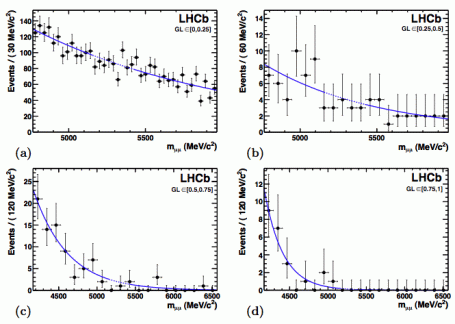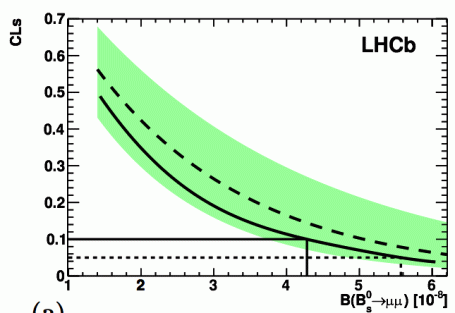Impressive New Results from LHCb
March 17, 2011 at 6:48 pm 2 comments
The LHCb Collaboration has accomplished with 37 pb-1 what the Tevatron experiments required several fb-1 to do. They put the limit (arXiv:1103.2465, 12-Mar-2011):
Br(Bs→μ+μ–) < 5.6 × 10-8 at 85% C.L.
Impressive!
What is this about? The Bs meson is neutral and contains a b-quark and an s-quark. In the standard model, the complete annihilation of these two quarks to produce a rather neutral but very distinctive μ+μ– pair is exceedingly rare – the predicted branching ratio is about 0.3×10-8. Since it is so very small, one can hope that new physics would lead to a large enhancement. Indeed, factors of 10 or a 100 are possible in SUSY if tanβ is large. Observation of this extremely rare decay would constitute an unequivocal discovery of physics beyond the standard model, albeit through a loop effect.
How did the LHCb Collaboration achieve such an impressive result? The main answer is: they have a wonderful detector and they made an intelligent analysis. Here are some of the salient points:
They are looking for a narrow peak on an almost-flat background, so the resolution on the μ+μ– mass is crucial. They truly have a wonderful spectrometer – the momentum resolution is 0.5% at 100 GeV, which is two or three times better than CMS, which is better that ATLAS. This means they can make a narrow window in which to look for Bs decays: they choose ±60 MeV to be compared to the ±120 MeV window from CDF. This already means less background.
Another important fact about their muon sample is its purity. Only 10% of the muons selected for this analysis are really hadrons decaying in flight. So their combinatorial and physics backgrounds can be studied and understood through simulations. In fact, though, their analysis makes minimal use of simulations and follows the kind of self-calibrating methods used in the CDF analysis (arXiv:0712.1708).
Aside from the mass, LHCb uses a so-called geometrical likelihood (GL) which incorporates topological and kinematic information independent from the mass: the decay time, the muon impact parameter, the B impact parameter, the distance of closest approach of the muons, a kind of isolation variable, and the pT of the B. This GL gives a huge boost to background suppression.
LHCb use an interesting strategy based on bins in mass and the GL. They fit the background and signal in each bin, knowing that some will have background only even if a Bs→μ+μ– signal is present. This allows a nice control of the data – it builds in the concept of control regions in an organic way. Here are the plots of the four bins in GL:
As you can see, there is plenty of background at low GL, which diminishes quickly for higher GL values. There are, alas, no peaks.
There are many other technical details that I won’t describe here. They concern the careful control of uncertainties on the efficiencies, the handling of the normalization modes and the trigger which is rather amazing in and of itself. Please read through the paper if this analysis interests you.
In the absence of signal, LHCb sets limits on the branching ratio using the standard CLs method:
Their limit is completely consistent with expectation, and compares well to the best limit from the Tevatron: 4.3×10-8, a preliminary CDF result based on 3.7 fb-1 — i.e., based on one hundred times more luminosity.
(Note: they also set a limit on Bd→μ+μ– but the interest from the SUSY point of view is with the Bs limit.)
This result will not extend exclusion regions in MSSM parameter space because it is not better than existing Tevatron bounds. But one expects some tens or hundreds of pb-1 by the summer, and at that point, LHCb might actually see a signal (even if only from the standard model). That would be very interesting indeed!
Entry filed under: Particle Physics.
2 Comments Add your own
Leave a comment
Trackback this post | Subscribe to the comments via RSS Feed


1. Marco | March 28, 2011 at 3:24 am
Marco | March 28, 2011 at 3:24 am
Hi Michael, thanks for your interest in our result and for its clear description!
I hope not to lower your excitement by a factor 10 in precising that LHCb’s analysis is based on 100 times less integrated luminosity than the precedent CDF result, and not 1000 as written in your blog.
Stay tuned for a combined Tevatron update to come soon and for the next LHCb’s result with the data being taken right now!
2. Michael Schmitt | April 5, 2011 at 11:36 am
Michael Schmitt | April 5, 2011 at 11:36 am
Hi Marco, thanks for the correction! I guess I was so enthusiastic that I added in a factor of ten without realizing it. 😉 I’m correcting the text now.
Michael